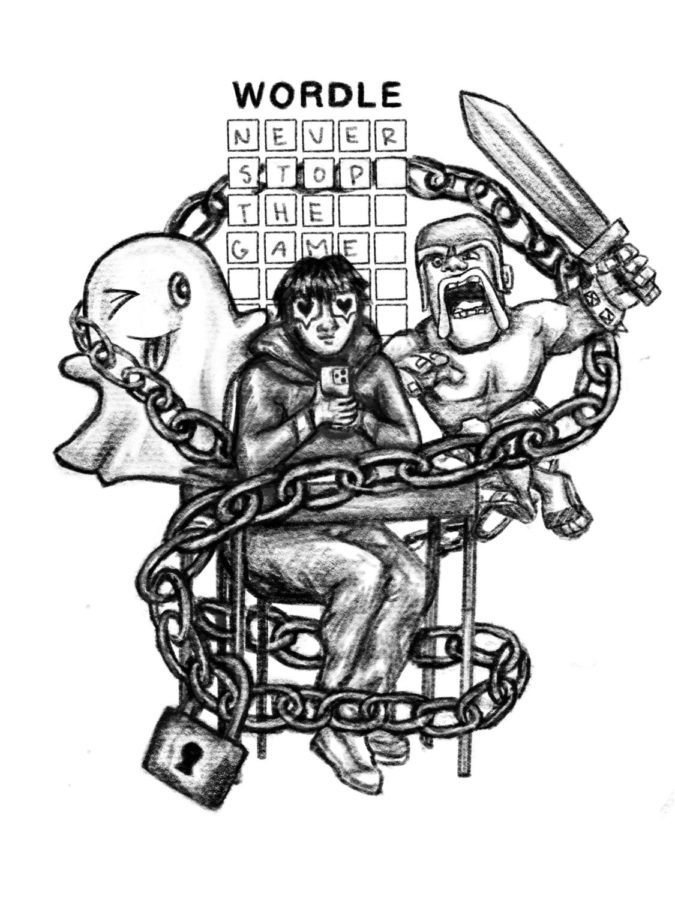Snapchat, “the fastest way to share a moment,” is used by over 75 percent of American teenagers ages 13-17 according to the Associated Press-NORC Center for Public Affairs Research. The social media app designed to allow people to communicate instantly with others through chats, photos and videos has taken younger generations by storm, as they turn to it as an efficient means of communication with their friends. Despite the app’s popularity, research shows, and Menlo students believe that Snapchat has significant downsides that might negatively impact younger teens.
Freshman Ruby Satsuky downloaded Snapchat in May 2021, which was later than most of her friends due to her parents’ strict rules about it. “The only reason I got it was to remain connected with old friends because I was moving,” she said. “Otherwise my parents wouldn’t have let me get it.”
While Satsuky appreciates being able to talk to her friends on Snapchat, she doesn’t find it necessary to stay in touch because she can text them on iMessage. She finds Snapchat to be more toxic than other platforms of communication. “With Snapchat, you can hide behind your phone and say horrible things you wouldn’t say in person,” Satusky said.
A key distinction between Snapchat and iMessage is that on Snapchat, most chats, photos and videos disappear after a certain amount of time whereas on iMessage they are all saved. Users are notified when their stories, messages and photos are screenshotted, so it is difficult for users to violate other’s privacy without them knowing. It is easy to send riskier photos with the knowledge that you will be notified if someone saves your message, otherwise it will disappear. Snapchat users, however, should be wary of the fact that, once something is released on the Internet, there is no guarantee it will remain private.
Due to the temporary nature of Snapchat messages, the app has become a popular platform for the distribution of explicit photos and messages. This behavior increases the risk of photos being leaked because they are temporary or uncomfortable situations of receiving unsolicited photos.
Satsuky has both been asked to send explicit photos as well as received unsolicited photos from boys on Snapchat. “If you are young and you get the app, it can be traumatizing,” she said. She is grateful that she got Snapchat when she was entering high school and not earlier because she can imagine the damaging effects it might have on a younger audience given how uncomfortable this experience makes her now. Snapchat has a minimum age requirement of 13 years old, however children can easily circumvent this restriction by simply entering a false birthdate.
One junior boy said he has exchanged explicit photos with a few girls before, but he has never asked without receiving what he thought to be signals from them first. “There are a lot of things that go into me asking; usually they give off hints that they want something,” he said. “I am not just gonna straight up ask them out of nowhere.”
Previously, he would ask later in a conversation when he felt he and the girl were clearly flirty with each other. The source points out that interactions regarding explicit photos were much more common in eighth grade and freshman year than they are now. He describes himself as lucky to have never had his photos leaked as far as he is aware after sharing them with about five girls.
Snapchat community guidelines prohibit accounts that promote or distribute pornographic content. All instances of child sexual exploitation go to authorities. “Never post, save or send nude or sexually explicit content involving anyone under the age of 18—even of yourself. Never ask a minor to send sexually explicit content,” reads Snapchat’s website. Despite these guidelines, the requesting and sending of explicit photos is an inevitable part of digital use amongst young people as romantic relationships expand into the online sphere. According to the Washington Post, in a survey of 5,593 students ages 12 to 17, 13 percent of adolescents said they have sent an explicit video or photo.
Senior Ella Hartmanis feels as though sending explicit photos should be a private interaction between two people, and the leaking of photos is a complete violation of privacy. “Although I have never sent nudes, I think it is up to the person about whether or not they are comfortable doing that, but there should be an expectation that the photos stay private,” she said. “Nudes being leaked [by someone] is looked down upon, it reduces people only to their body.”
Another junior boy got the app at the end of his sophomore year. He has received unsolicited photos from girls that ultimately impacted his perception of them. “It caught me off guard, I didn’t know how to proceed with a normal relationship after that,” he said. He has never explicitly asked a girl to send nude photos, but he has hinted at it. “After talking for a bit, […] I asked to see her [outfit], but it was obviously intentional,” he said.
Snapscore and Snap Map are features of Snapchat that can be toxic due to stigmas associated with them. A person’s Snapscore represents the total number of snapchats they have sent and received, so a high Snapscore means someone likely uses Snapchat a lot and communicates with many people.
Sophomore Ryan Schnell points out that generalizations are made based on Snapscore, and that a high Snapscore is seen as a negative. This does not only apply to girls, as boys with high snapscores are often deemed to be players, or guys who flirt with multiple girls at once, according to Hartmanis. But Schnell believes that people should not jump to conclusions based off of a Snapscore. “Maybe they have had Snapchat for 10 years,” Schnell said.
Snap Map is another aspect of Snapchat that can foster toxicity. If a person turns on their location, anyone they have added on Snapchat can see their location based on when they were last using Snapchat.
Sophomore Stella Buch finds Snap Map to be more negative than Snapscore, as she believes it was designed to show when and where friends are hanging out, leading to exclusivity. “[Snap Map] is designed to show you when your friends are hanging out without you, which makes you feel left out,” she said.


